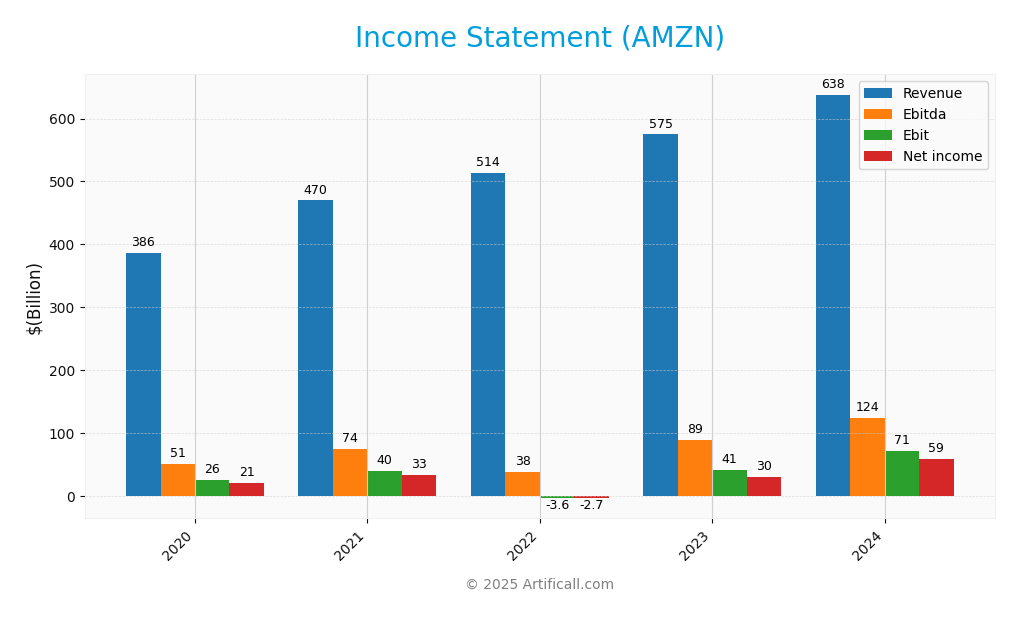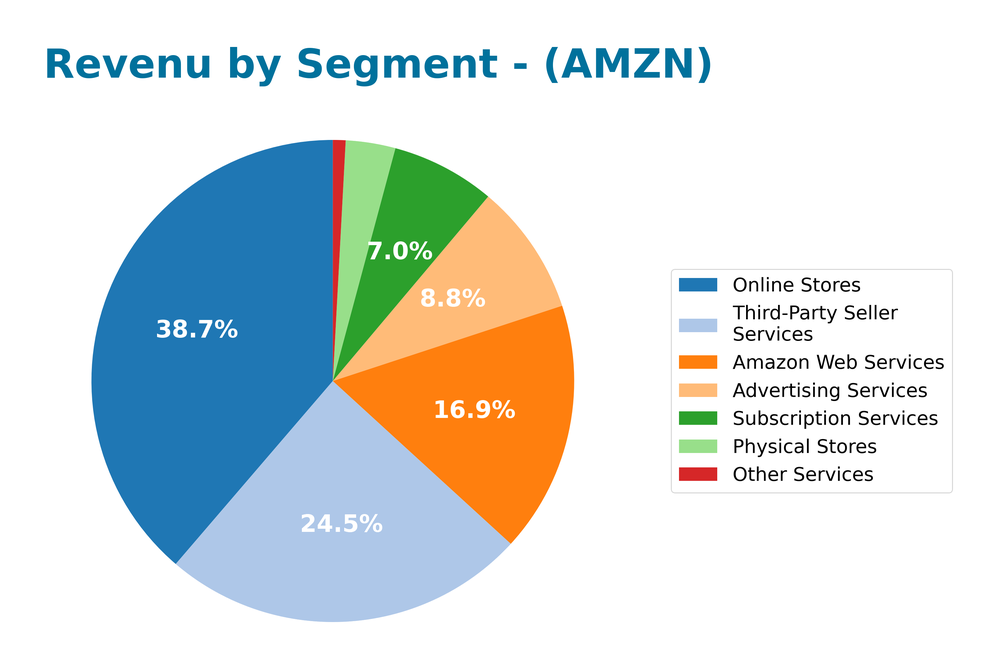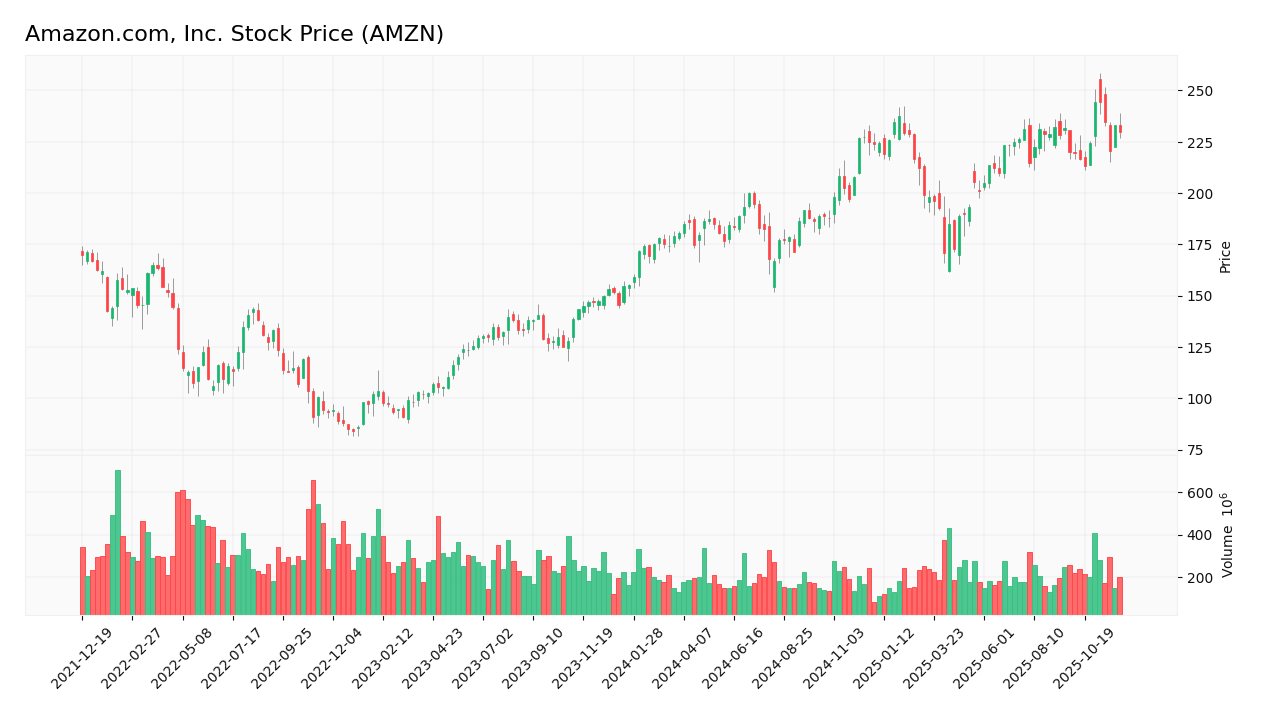Amazon.com, Inc. revolutionizes how we shop, stream, and connect in our everyday lives, transforming the retail landscape with its innovative approach. As a titan in the specialty retail industry, Amazon excels not only in e-commerce but also through its cutting-edge cloud services via AWS. With a reputation built on quality and a relentless drive for innovation, the company continues to set the pace for competitors. As we analyze its current market position, the pressing question remains: do Amazon’s fundamentals still support its lofty valuation and promising growth trajectory?

Table of contents
Company Description
Amazon.com, Inc. (ticker: AMZN), founded in 1994 and headquartered in Seattle, WA, is a global leader in the specialty retail industry. The company operates through three primary segments: North America, International, and Amazon Web Services (AWS). Its diverse offerings range from e-commerce retailing of consumer products, both proprietary and third-party, to innovative electronic devices like Kindle and Echo, as well as comprehensive cloud computing services. With a formidable market capitalization of approximately $2.45T and a workforce of 1.56M employees, Amazon plays a pivotal role in shaping modern commerce through its relentless focus on customer satisfaction, technological innovation, and an evolving digital ecosystem.
Fundamental Analysis
This section will analyze Amazon.com, Inc.’s income statement, financial ratios, and dividend payout policy to assess its overall financial health and investment potential.
Income Statement
The following table presents the income statement for Amazon.com, Inc. (AMZN) over the past five fiscal years, highlighting key financial metrics.

| Metric | 2020 | 2021 | 2022 | 2023 | 2024 |
|---|---|---|---|---|---|
| Revenue | 386.06B | 469.82B | 513.98B | 574.79B | 637.96B |
| Cost of Revenue | 233.31B | 272.34B | 288.83B | 304.74B | 326.29B |
| Operating Expenses | 129.86B | 172.60B | 212.90B | 233.19B | 243.08B |
| Gross Profit | 152.76B | 197.48B | 225.15B | 270.05B | 311.67B |
| EBITDA | 51.01B | 74.39B | 38.35B | 89.40B | 123.82B |
| EBIT | 25.83B | 39.96B | -3.57B | 40.74B | 71.02B |
| Interest Expense | 1.65B | 1.81B | 2.37B | 3.18B | 2.41B |
| Net Income | 21.33B | 33.36B | -2.72B | 30.43B | 59.25B |
| EPS | 2.13 | 3.30 | -0.27 | 2.95 | 5.66 |
| Filing Date | 2021-02-03 | 2022-02-04 | 2023-02-03 | 2024-02-02 | 2025-02-07 |
Interpretation of Income Statement
Over the past five years, Amazon has demonstrated significant growth in revenue, increasing from 386.06B in 2020 to 637.96B in 2024. Net income has also shown a positive trajectory, rebounding from a loss of -2.72B in 2022 to a solid profit of 59.25B in 2024. Margins improved notably in the most recent year, with gross profit rising significantly alongside EBITDA. This reflects effective cost management and increased operational efficiency, suggesting a strong recovery and growth potential for investors. However, I remain cautious, as market dynamics could impact future performance.
Financial Ratios
Here are the financial ratios for Amazon.com, Inc. across the last few fiscal years.
| Ratios | 2020 | 2021 | 2022 | 2023 | 2024 |
|---|---|---|---|---|---|
| Net Margin | 5.53% | 7.10% | -0.53% | 5.29% | 9.29% |
| ROE | 22.84% | 24.13% | -1.86% | 15.07% | 20.72% |
| ROIC | 10.36% | 8.72% | 1.83% | 8.23% | 13.15% |
| P/E | 76.34 | 50.57 | -314.43 | 51.46 | 38.78 |
| P/B | 17.44 | 12.20 | 5.86 | 7.76 | 8.03 |
| Current Ratio | 1.05 | 1.14 | 0.94 | 1.05 | 1.06 |
| Quick Ratio | 0.86 | 0.91 | 0.72 | 0.84 | 0.87 |
| D/E | 0.90 | 0.84 | 0.96 | 0.67 | – |
| Debt-to-Assets | 26.27% | 27.68% | 30.28% | 25.69% | 20.95% |
| Interest Coverage | 13.90 | 13.75 | 5.17 | 11.58 | 28.51 |
| Asset Turnover | 1.20 | 1.12 | 1.11 | 1.09 | 1.02 |
| Fixed Asset Turnover | 2.56 | 2.17 | 2.03 | 2.08 | 1.94 |
| Dividend Yield | 0% | 0% | 0% | 0% | 0% |
Interpretation of Financial Ratios
Analyzing Amazon.com, Inc. (AMZN), the financial ratios for FY 2024 indicate a mixed picture of financial health. The current ratio is 1.06, suggesting adequate liquidity, although the quick ratio at 0.87 raises some concern about immediate liquidity. The solvency ratio of 0.33 is moderate, reflecting manageable debt levels, but the debt-to-equity ratio of 0.46 indicates a reliance on debt financing. Profitability ratios such as a net profit margin of 9.29% are decent, although the price-to-earnings ratio of 38.78 suggests the stock may be overvalued. Overall, while liquidity and profitability ratios are acceptable, the reliance on debt and high valuation could pose risks.
Evolution of Financial Ratios
Over the past five years, AMZN’s financial ratios show a general improvement in profitability, with the net profit margin increasing from negative to positive. However, the liquidity ratios have fluctuated, with the current ratio showing a slight increase, indicating gradual improvement in short-term financial health.
Distribution Policy
Amazon.com, Inc. (AMZN) does not pay dividends as it continues to prioritize reinvestment in growth initiatives and research and development. This strategy is aligned with its high-growth phase, aiming to enhance long-term shareholder value. While there are no dividends, Amazon engages in share buybacks, utilizing excess cash to return value to shareholders. Overall, this approach supports sustainable long-term value creation by focusing on expansion and innovation rather than immediate payouts.
Sector Analysis
Amazon.com, Inc. operates within the Specialty Retail industry, offering a diverse range of products through its robust e-commerce platform and physical stores, while competing with giants like Walmart and Alibaba.
Strategic Positioning
As of 2025, Amazon.com, Inc. (AMZN) commands a significant market share in the specialty retail sector, bolstered by its dual focus on e-commerce and cloud services through AWS. The company’s extensive product offerings and third-party seller programs reinforce its competitive advantage, although it faces mounting pressure from rivals like Walmart and Alibaba. Additionally, technological disruptions, particularly in AI and logistics, are shaping the retail landscape, compelling Amazon to innovate continuously. Despite these challenges, its robust market capitalization of approximately $2.45T reflects investor confidence in its long-term growth potential.
Revenue by Segment
The following chart illustrates Amazon’s revenue distribution across various segments for the fiscal year 2024, showcasing the performance of its diverse business lines.

In FY 2024, Amazon experienced significant growth across several segments. Notably, Online Stores generated $247B, maintaining its position as the leading revenue driver. Amazon Web Services (AWS) also performed robustly at $108B, reflecting continued demand for cloud services. Advertising Services surged to $56B, indicating a notable shift toward monetizing its platform. However, the overall growth rate appears to be slowing compared to previous years, suggesting potential margin pressures and market saturation in key segments. As such, risk management strategies should be prioritized to navigate these challenges effectively.
Key Products
Amazon.com, Inc. offers a diverse range of products across various segments. Below is a table summarizing some of the key products that contribute to its market presence.
| Product | Description |
|---|---|
| Amazon Prime | A subscription service that provides members with benefits such as free shipping, streaming video, and music services. |
| Kindle | An e-reader device that allows users to purchase, download, and read digital books and content. |
| Fire Tablets | A line of affordable tablets that offer access to apps, streaming services, and Amazon content. |
| Fire TV | A digital media player that allows users to stream content from various platforms, including Amazon Prime Video. |
| Echo | A smart speaker powered by Alexa, enabling voice interaction, music playback, and smart home control. |
| Amazon Web Services (AWS) | A comprehensive cloud computing platform that offers services such as computing power, storage, and databases to businesses. |
| Blink | A home security camera system that provides users with smart monitoring capabilities. |
| eero | A mesh Wi-Fi system designed to enhance home internet connectivity. |
| Amazon Music | A music streaming service that offers a vast library of songs and playlists to subscribers. |
| Twitch | A live streaming platform for gamers and content creators, allowing users to broadcast and watch gameplay. |
These products illustrate Amazon’s commitment to innovation and customer satisfaction across multiple sectors.
Main Competitors
In the competitive landscape of the specialty retail sector, Amazon.com, Inc. faces various notable competitors. Below is a table showcasing the main competitors, including Amazon itself, sorted by market capitalization.
| Company | Market Cap |
|---|---|
| Amazon.com, Inc. | 2.45T |
| Alibaba Group Holding Limited | 367.21B |
| Casey’s General Stores, Inc. | 21.08B |
| GameStop Corp. | 10.30B |
| Etsy, Inc. | 5.26B |
| RH | 3.02B |
| ATRenew Inc. | 1.93B |
| Revolve Group, Inc. | 1.85B |
| Liquidity Services, Inc. | 928.90M |
| Tandy Leather Factory, Inc. | 22.61M |
| LightInTheBox Holding Co., Ltd. | 17.34M |
The primary competitors include established players within the global specialty retail market, where Amazon leads with a significant market cap, followed by Alibaba and other notable companies like Casey’s and GameStop.
Competitive Advantages
Amazon.com, Inc. (AMZN) holds a dominant position in the retail sector due to its vast product range and innovative technologies. Its successful integration of e-commerce with Amazon Web Services (AWS) positions it uniquely against competitors. The future outlook remains bright, with potential for new product launches in smart home technologies and expansion into emerging markets. Furthermore, continued investment in logistics and fulfillment capabilities will enhance customer experience and drive sales growth, making AMZN an attractive option for investors seeking long-term growth.
SWOT Analysis
The SWOT analysis highlights the key internal and external factors affecting Amazon.com, Inc. (AMZN) to inform strategic decision-making.
Strengths
- Strong market position
- Diverse revenue streams
- Robust logistics network
Weaknesses
- High dependence on e-commerce
- Thin profit margins in retail
- Regulatory scrutiny
Opportunities
- Growth in cloud services
- Expansion into new markets
- Increasing demand for online shopping
Threats
- Intense competition
- Economic downturns
- Cybersecurity threats
The overall SWOT assessment suggests that while Amazon has a solid foundation and promising growth avenues, it must navigate external challenges and internal weaknesses strategically to sustain its market leadership.
Stock Analysis
Over the past year, Amazon.com, Inc. (AMZN) has demonstrated significant price movements, culminating in a notable bullish trend characterized by a 48.45% increase in stock price.

Trend Analysis
Analyzing the stock’s performance over the past year reveals a strong bullish trend with a price change of +48.45%. This indicates a sustained upward momentum, with notable highs reaching 244.41 and lows at 154.62. The trend is currently showing acceleration, supported by a standard deviation of 22.73, suggesting that the price has experienced considerable fluctuations during this period.
However, in the recent trend from September 21 to December 7, 2025, the stock has seen a slight decline of -0.84%. The trend slope remains marginally positive at 1.1, indicating a potential stabilization phase despite the recent dip.
Volume Analysis
In terms of trading volume over the last three months, the total volume reached approximately 25.53B, with buyer volume at 14.68B and seller volume at 10.64B. However, the overall volume trend is decreasing, suggesting a waning interest among investors. The recent period shows a shift towards slightly seller-dominant behavior, with buyer volume at 1.29B and seller volume at 1.61B, leading to a buyer dominance percentage of 44.51%. This shift may reflect caution among investors, potentially signaling a more bearish sentiment in the short term.
Analyst Opinions
Recent analyst recommendations for Amazon.com, Inc. (AMZN) indicate a consensus rating of “Buy.” Analysts emphasize the company’s strong return on equity (5) and return on assets (5), showcasing its efficient management of resources. However, concerns about its debt-to-equity (2) and price-to-earnings (2) ratios suggest caution. The overall score stands at 3, with notable mentions from analysts highlighting Amazon’s growth potential despite current market challenges. As an investor, I see the positive outlook as a reason to consider adding AMZN to my portfolio, while remaining aware of the risks involved.
Stock Grades
Amazon.com, Inc. (AMZN) has garnered consistent support from various reputable grading companies, indicating a solid confidence in its performance.
| Grading Company | Action | New Grade | Date |
|---|---|---|---|
| Rosenblatt | Maintain | Buy | 2025-12-04 |
| Wedbush | Maintain | Outperform | 2025-12-03 |
| B of A Securities | Maintain | Buy | 2025-12-03 |
| Citizens | Maintain | Market Outperform | 2025-12-03 |
| Wells Fargo | Maintain | Overweight | 2025-12-02 |
| Oppenheimer | Maintain | Outperform | 2025-12-01 |
| Rosenblatt | Maintain | Buy | 2025-11-25 |
| Rothschild & Co | Downgrade | Neutral | 2025-11-18 |
| Mizuho | Maintain | Outperform | 2025-11-04 |
| Rosenblatt | Maintain | Buy | 2025-11-04 |
Overall, the trend shows a strong preference for maintaining or holding positive ratings, with most companies continuing to support a “Buy” or “Outperform” stance. The recent downgrade by Rothschild & Co is notable but appears to be an outlier in an otherwise favorable assessment landscape.
Target Prices
The consensus among analysts for Amazon.com, Inc. (AMZN) presents a range of target prices that reflect their expectations.
| Target High | Target Low | Consensus |
|---|---|---|
| 340 | 265 | 299.72 |
Overall, analysts anticipate a moderate growth trajectory for AMZN, with a consensus target price suggesting potential appreciation from current levels.
Consumer Opinions
Consumer sentiment about Amazon.com, Inc. (AMZN) is a mix of admiration for its convenience and frustration over customer service.
| Positive Reviews | Negative Reviews |
|---|---|
| “Fast shipping and a wide product selection!” | “Customer service was unhelpful during my issue.” |
| “Great prices and easy return process.” | “Frequent package delays in my area.” |
| “User-friendly website and app.” | “I had a problem with a damaged item, took too long to resolve.” |
Overall, consumer feedback highlights Amazon’s strengths in product variety and shipping speed, while recurring weaknesses include customer service responsiveness and delivery issues.
Risk Analysis
In evaluating Amazon.com, Inc. (AMZN), it’s crucial to consider the following risks that could impact the investment landscape.
| Category | Description | Probability | Impact |
|---|---|---|---|
| Market Competition | Intense competition from retail and tech giants can erode market share. | High | High |
| Regulatory Changes | Increasing scrutiny and potential regulations in e-commerce and data privacy. | Medium | High |
| Supply Chain Issues | Disruptions in logistics and supply chain may affect product availability. | Medium | Medium |
| Economic Downturn | A recession could lead to decreased consumer spending on discretionary items. | High | High |
| Technological Failures | System outages or cyber attacks could compromise customer trust. | Medium | High |
The most significant risks for AMZN involve market competition and regulatory changes, both of which have substantial potential impacts on profitability and growth.
Should You Buy Amazon.com, Inc.?
Amazon.com, Inc. (AMZN) has demonstrated strong profitability with a net profit margin of 9.29% for the fiscal year 2024, indicating effective cost management. Despite a substantial total debt of 130.9B, the company’s debt-to-equity ratio is relatively low at 0.053, suggesting a sound capital structure. The fundamentals have evolved positively, with a return on invested capital (ROIC) of 13.15%, exceeding the weighted average cost of capital (WACC) of 9.83%, which implies value creation. The current rating is B+, reflecting a balanced view of the company’s performance and potential.
Favorable signals
I have identified several favorable elements in the data for Amazon.com, Inc. The company exhibits a robust revenue growth rate of 10.99%, along with a strong gross margin of 48.85%. Additionally, the gross profit growth rate stands at 15.41%, and the EBIT margin is notably at 11.13%. Furthermore, the company shows impressive EBIT growth of 74.33% and an encouraging net margin of 9.29%. The net margin growth of 75.45% and EPS growth of 90.69% further strengthen the positive outlook.
Unfavorable signals
Conversely, there are a few unfavorable elements in the data. The price-to-earnings (P/E) ratio is at 38.78, which could be seen as overvalued. Similarly, the price-to-book (P/B) ratio stands at 8.03, indicating potential overvaluation. Lastly, the dividend yield is at 0%, which may not appeal to income-focused investors.
Conclusion
Given the favorable global income statement opinion and the favorable ratios evaluation, Amazon.com, Inc. may appear to be an attractive option for long-term investors. However, with the recent seller volume exceeding the buyer volume, it might be preferable to wait for buyers to return before making any investment decisions.
Disclaimer: This article is not financial advice. Each investor is responsible for their own investment decisions.
Additional Resources
- Amazon.com, Inc. (AMZN): A Bull Case Theory – Yahoo Finance (Dec 05, 2025)
- Amazon (NASDAQ: AMZN) Stock Price Prediction in 2030: Bull, Bear, & Baseline Forecasts (Dec 5) – 24/7 Wall St. (Dec 05, 2025)
- Amazon (AMZN) Stock: Falls Despite Sansiri GenAI Launch on AWS – CoinCentral (Dec 05, 2025)
- B of A Securities Maintains Amazon.com (AMZN) Buy Recommendation – Nasdaq (Dec 04, 2025)
- What’s Going On With Amazon Stock Friday? – Amazon.com (NASDAQ:AMZN) – Benzinga (Dec 05, 2025)
For more information about Amazon.com, Inc., please visit the official website: amazon.com



